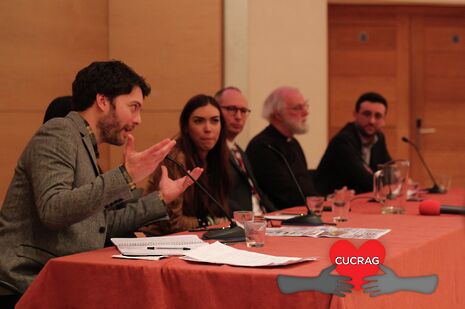John Domokos: ‘Journalists, advocates and activists all have to do their jobs’
Through what lens do we view the refugee crisis? The Guardian‘s top video journalist relives trying to capture people’s stories in Calais with Anna Fitzpatrick

“When people see the human face of the refugee challenge, things do change”, reflects Dr Rowan Williams, the former Archbishop of Canterbury and Master of Magdalene College, as he sits alongside John Domokos at a panel event organised by CUCRAG.
Having produced video coverage from Calais for The Guardian, Domokos has certainly committed himself to capturing this alternative image of the current refugee crisis. After all, as he points out: “there’s a lot of misreporting and negative reporting of immigration”.
Domokos is quick to recall one poignant example, telling me that while he has “met all sorts of people in Calais”, there is “one boy in particular who really sticks in my mind. After meeting him in a little makeshift youth club in Calais – the so-called ‘jungle’ – the next I saw of him was on the front pages of the Daily Mail. They’d done a big splash about how these people coming over weren’t ‘children’ and that they’d lied about their age.”
“There was a ridiculous out-roar,” he continues with a sigh. “They were claiming that we’d been ‘conned’! I was outraged to see this boy being used for one of the photos. He’d told me he was 16 and, as far as I could tell, that was extremely believable. He was very vulnerable and traumatised by things that had happened to him – he’d lost his parents in Afghanistan. I’d met him and spent several hours with him. I could see that he needed help, not trial by press.”
“There was a sense of the walls literally closing in on this place and it was very visceral in the air. That’s what I wanted to convey.”
But while Domokos is quick to lament the negative coverage of refugees in, typically, the tabloid press, he is also adamant that the narratives in other sections of the media are problematic, too. “I don’t like the way refugees are often portrayed in the media – as victims, or objects for our sympathy”, Domokos begins. “I’ve tried in my own films to get away from this and to show them as people, rather than just ‘refugees’.”
Describing such portrayals as “an easy trap to fall into when covering the crisis as journalists”, he laments the “formulaic nature” of “a lot of TV news packages. The reporter stands there and tells you all the information, then they have a few vox pops of people and then some shots of them looking all sorry and sad. That’s caricaturing it a bit”, he grimaces. “I try to humanise people.”
With this in mind, what exactly was the different angle he was trying to show in his own footage? “The last time I was there, I was trying to show that there was a sense of desperation growing in the camp because the French government had said they were going to bring the camp to the ground”, he explains.
“People knew that the clock was ticking and they knew also that getting into Britain was getting harder and harder. Fences and walls were springing up. So there was a sense of the walls literally closing in on this place and it was very visceral in the air. That’s what I wanted to convey”.

Domokos is also keen to point out that his footage aimed to dispel a number of major misconceptions currently accepted by sections of the British public. After all, returning to his emphasis on the age of many of the refugees, it is important not to forget “the fact that many of these people were young [and] although they might not be eight year-olds clutching teddy bears, they might have facial hair and they might look a bit adolescent, they’re still vulnerable and need help”.
“It’s rare to pick up sticks, walk out of a country, carry all of their possessions on their back, put their children in a dingy across the sea and live in squalid conditions for weeks unless they’re fleeing something worse than that.”
Another fallacy Domokos has sought to challenge in his videos is “the misconception that refugees don’t have any money”. In explanation, he points out that “refugees are not necessarily poor. A lot of these people do have money – they’re middle class.”
“And if they weren’t”, he tells me, “they wouldn’t have the means to get out in the first place because they have to pay smugglers. The people who are coming to Europe – they very often are from middle-class backgrounds or owned businesses”.
I wonder if this offers support for the argument put forward by those who object to the UK government providing aid, support and refuge to these refugees that many of these people may actually be economic migrants, simply seeking a better life for their families in the West.
But Domokos is dismissive towards this line of reasoning, noting that “for most people – especially for a family – it’s rare to pick up sticks, walk out of a country, carry all of their possessions on their back, put their children in a dingy across the sea and live in squalid conditions for weeks unless they’re fleeing something worse than that. Most of the people I met, they’re fleeing war or conflict – the direct threat of it,” he says with a degree of finality.
While Domokos’s work has been featured heavily on The Guardian website and well-shared on social media, I query the extent to which it can truly help tackle the misconceptions of the British public, given that many stem from stories in the tabloid press.
“Much of the media [were trying] to show this reality”, he continues, “and I think that started feeding into people’s understanding. Of course, there was that time when the picture of Alan Kurdi was published on the front page of lots of newspapers. That, I think, was a tipping point. It didn’t come out of nowhere – that feeling had been building”.
But Domokos possesses a sense of hope, explaining to me that he is “sure that the Daily Mail and co are as much keen to follow as they are to lead public opinion”. I wonder, then, how far social media can shape the frames of mainstream debate. “Social media does enable people to broadcast themselves, to spread news [so] that was kicking off as well. Volunteers from camps were sending messages, pictures, and recordings back from these places. So there was a build-up of feeling”, he reflects.
But it is questionable whether, in light of what seems to be a spike in nationalism in the wake of Brexit and Trump, this feeling is beginning to subside. I wonder if Domokos believes this will shape the way we respond to future refugee crises? “The pendulum has definitely swung in one direction”, Domokos admits, before responding with a clear solution. “I think it’s important for people to advocate, to report. It’s important for us to stick to facts. Journalists, advocates and activists all have to do their job and they’ve got to do it firmly and energetically.”
 Comment / Plastic pubs: the problem with Cambridge alehouses 5 January 2026
Comment / Plastic pubs: the problem with Cambridge alehouses 5 January 2026 News / Cambridge businesses concerned infrastructure delays will hurt growth5 January 2026
News / Cambridge businesses concerned infrastructure delays will hurt growth5 January 2026 News / New movement ‘Cambridge is Chopped’ launched to fight against hate crime7 January 2026
News / New movement ‘Cambridge is Chopped’ launched to fight against hate crime7 January 2026 News / Uni-linked firms rank among Cambridgeshire’s largest7 January 2026
News / Uni-linked firms rank among Cambridgeshire’s largest7 January 2026 News / AstraZeneca sues for £32 million over faulty construction at Cambridge Campus31 December 2025
News / AstraZeneca sues for £32 million over faulty construction at Cambridge Campus31 December 2025









